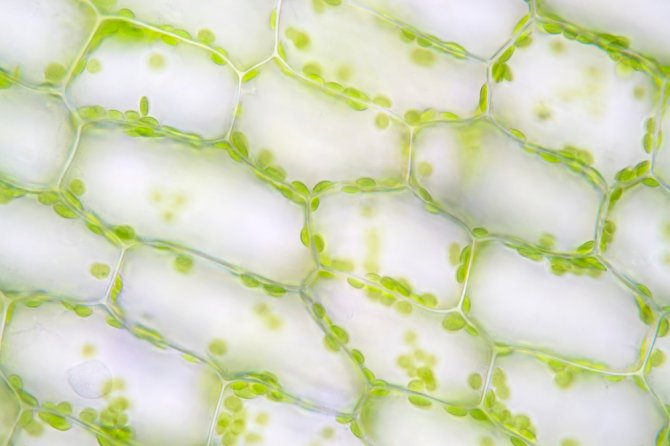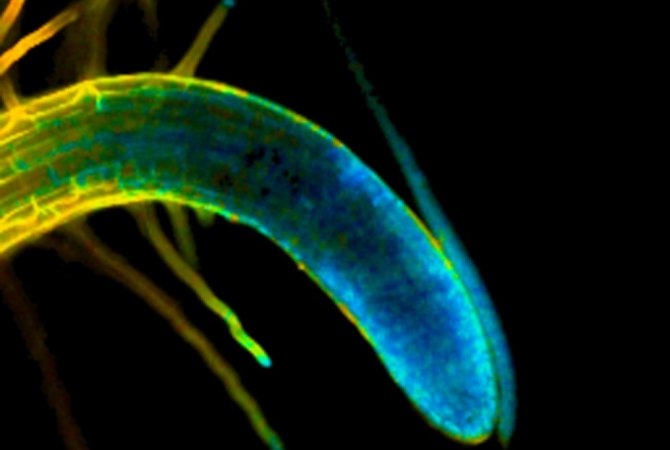
Connecting story
How to find the answer to a 150-year-old biological problem
In the coming years, professors Dolf Weijers and Joris Sprakel are tackling a 150-year-old biological puzzle: how do plants sense and respond to touch? For this endeavour, they were awarded the Gravitation Subsidy of over 22 million euros last month. They owe their success to accidental discoveries, the intersection of their expertise, and by staying close to their own interests. "We devised the research proposal purely from topics we find fascinating."
It started as a routine meeting with a graduate student in the office. "Hey, take a look at this," said Yosapol Harnvanichvech—the graduate student in question—and pressed the play button on his laptop. On the screen appeared a video of a plant embryo (a clump of cells), being pushed through an ultra-narrow channel. The goal? To break up the embryo into individual cells. Instead, the clump of cells stretched to squeeze through the opening and once on the other side, it popped back into its original, lollipop-like shape. "We immediately knew: we could do something with this," says Dolf Weijers, professor of biochemistry. Completely by chance, the PhD student had developed a method to exert very controlled force on a mini-plant.
There is something missing in plant biology
Charles Darwin already described how plants react to force and touch in his book 'The Power of Movement in Plants' in 1880. But only now are scientists beginning to map out these invisible forces. And it's high time, thinks mechanobiologist Joris Sprakel. "There is something missing in plant biology," he states. Based solely on genes and biochemistry, biologists can almost accurately predict how a cell or plant grows or behaves. Almost. Because things often just do not quite add up. "That's because cells are more than just a bag of genes and biological substances," says Sprakel. "They exist in a physical world with neighbours that push and pull on them." If you ignore the forces they exert on each other, you cannot fully understand how plants function, Sprakel believes.

Yet, biologists have long refrained from researching how such cells perceive and respond to the touch of their neighbours and the outside world for a long time. Weijers was no exception. "That's because such forces are abstract and we could not measure them in any way," he says. But that changed in 2018, during a chance encounter of disciplines at the 100th anniversary symposium of WUR. "I was in the audience," recalls Weijers. On stage, Sprakel presented self-made fluorescent molecules that change colour when they feel pressure. "In this case, it was about forces in synthetic materials, but it immediately became clear to me that this would be a valuable tool in plant biology," says Weijers.
What Weijers did not know was that Sprakel was adrift at that point in his career. He worked on synthetic materials at the chair group Physical Chemistry and Soft Matter. "Research into synthetic materials often revolves around problem-solving, such as making paint more durable with more water and fewer solvents. I missed the 'bigger' questions that I could sink my teeth into for twenty years and was ready for a new challenge," says Sprakel. When Dolf approached him during the anniversary reception and proposed a collaboration, he didn't have to think long. And so, the two got to work. They adapted Sprakel's self-built tool into a force sensor that also functions in living plant cells.
When they first met, the two professors were definitely not fans of each other
This led to the graduate student Harnvanichvech having a tool to apply force on plant cells in a controlled manner and measure that force. He identified important proteins (building blocks) in the plant cell that respond to such force. A good first indication that external forces are converted into a biochemical signal that the cell understands. To unravel the precise mechanism, Weijers and Sprakel decided to write a research proposal. "One Friday morning, we sat down together in the office and came up with a research proposal purely based on topics we find fascinating," says Weijers. In no time, they had the main theme down: investigating the sense of touch in plants. "But also the subtopics, how they were interconnected, and which researchers we wanted to involve in this project," Weijers explains. "When we looked at the clock, to our surprise, only one hour had passed."

The fact that the two are clearly well attuned to each other is also evident in the way they present their project in an accessible manner. They nearly complete each other's sentences. "We often think along the same lines," Sprakel agrees. But it was not always that way. When we first met - years before the centenary - we were definitely not fans of each other,” he says, laughing. That was during an interview about how to present top science. The two completely disagreed. "I said that it mostly required a lot of money, but Dolf found that way too simplistic," Sprakel recalls. "He argued that top science is only possible by creating an academic atmosphere with lots of dialogue and interaction between researchers from different disciplines."
Without money, you can still do good science, but without an academic climate, you cannot.
Meanwhile, Sprakel has revised his opinion and experiences daily how valuable interdisciplinary collaborations are. "Without money, you can still do good science, but without an academic climate, you cannot." Moreover, one thing can lead to another. It is precisely because of an interdisciplinary approach that the professors now receive 22.8 million euros for their research. Other researchers will join the consortium, including colleague plant scientists from Wageningen, Utrecht, and Nijmegen, as well as an experimental physicist from Amsterdam, materials scientists from Groningen and Eindhoven, and theorists from Wageningen and Leiden. For most researchers in the consortium, studying touch in plants is a completely new topic. Yet, they were all enthusiastic when approached by the Wageningen scientists. "That enthusiasm was motivating and confirmed our confidence in the project."
With the fortuitous discovery by graduate student Harnvanichvech to put controlled pressure on plant cells, Sprakel's special mechanical sensor, and other modern tools, researchers can finally integrate mechanics and physical forces into biology. In the coming years, they will unravel precisely how this works in various plant species. And if all goes well? Then scientists might use this knowledge to help plants better fight invading pathogens.